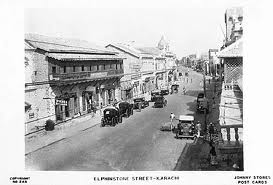
Karachi, the first Capital of Pakistan and its financial hub, is a leading Industrial centre and great Seaport. Karachi accounts for a lion’s share in the GDP and generates 65% of Pakistan’s total revenue.
According to legend, Karachi was named after ‘Mai-Kolachi’, a Sindhi – Baloch fisher-woman. Initially it was a small village named ‘Kolachi jo goth’ (The village of Kolachi). Soon it grew into a bigger village and the short name Kolachi remained to mark its identity. It was only in 19th Century, it got its present name, Karachi.
The British had their sights set upon Karachi when they opened up a factory in 1795. The factory was soon shut down due to differences with the then rulers, the Talpurs. However, this village lying by the mouth of the Indus river had caught the attention of the British East India Company, who, after sending a couple of exploratory missions to the area, conquered the town on February 3, 1839. In 1840, it was made capital of Sindh and was added to Bombay Presidency.
Soon after the arrival of British, Karachi was connected to rest of India by rail. Many public projects were launched like ‘The Empress Market’, ‘Frere Hall’ etc. A large number of Hindu Sindhis, Parsis, Gujaratis and Kutchis settled in the city when the British embarked upon a large-scale modernization of the city, and it was made the business hub of the subcontinent. In 1914, Karachi became the largest grain exporting port of the British Empire.
A little fort was constructed for protection and it had two main gateways: one facing the sea, known as Kharo Dar(Brackish Gate) and the other facing the adjoining Lyari river, known as the Mitho Dar (Sweet Gate). These places are now known as Kharadar and Meethadar.
In the 1941 census, Karachi had 51% Hindus, 43% Muslims and rest of the 6% were Parsis, Sikhs, Christians, Buddhists, Jews, Jains, and Bahais. 73% of the Karachites stated their mother tongue as Sindhi, 6.2% stated Urdu/Hindi. Gujarati and Balochi were the two other major languages spoken in Karachi. This was a city where people from all religions, languages, colors, races lived very peacefully and made it one of the most prominent and prosperous cities in Asia.
Sindhi Hindus and Parsis constructed the finest schools, colleges, libraries, hospitals, public and elite clubs during British rule. Historical places like Dayaram Jethmal College (DJ Science College), Narayan Jagannath Vaidya School (NJV High school), Hindu gymkhana etc were constructed by Sindhi Hindus and Jahanghir Kothari Parade, Edulji Dinshaw dispensaries were constructed by Parsis.
The partition of India and formation of Pakistan changed the fate of Karachi and transformed it totally. Despite partition, the non-Muslims (Hindus, Buddhists, Jains, Jews & Sikhs) living in the city did not want to leave for India, and preferred to stay back. However the situation became so adverse that they were forced to flee their livelihood and homes. Majority of the Hindus, Parsis, Sikhs and Jains left for India in Feb-March 1948, when the city witnessed Hindu-Muslim riots.
Soon the effect of the partition was showing on Karachi, names of many historical places were changed, like ‘Ram Bagh’ to ‘Aaram bagh’, ‘Gandhi garden’ to ‘Karachi zoological garden’, ‘Victoria Road’ to ‘Abdullah Haroon Road’, ‘Hindu gymkhana’ to ‘National Academy of Performing arts’, ‘Bunder road’ to ‘MA Jinnah Road’. Laloo Khet, which was the farm of a Hindu landlord named Lalchand, was renamed Liaquatabad.
I fail to understand what message Pakistan was trying to give the world by changing the names of such historical places. This act of insanity in renaming places reminds me of what Hassan Nisar, Pakistan’s renowned analyst had to say, “Jo qoumein apni tareekh ko mashq karti hai tarekh un ko mashq kar deti hai” (Those nations which distort their history; are vandalized by history itself).
History was distorted, non-Muslims were forced to leave city for India, and the people who took pride in their City were no longer there and were replaced by new immigrants who started influencing the very culture of the City. Despite this initial set back, Karachi limped back to normal and it remained peaceful to a large extent till the 1970s. The city had clubs, pubs, and discos. Shopping areas used to remain open the whole night (especially Tariq road).
However, this city had to face much tougher times during Bhutto’s and later Zia’s regimes, when forced Islamization was thrust upon the citizens of Karachi. All the above mentioned establishments were closed, and instead, we were only left with selected liquor shops which were supposed to cater to only non-Muslims.
The once peaceful Karachi is today amongst the most dangerous and unsafe metropolitan cities in the world. A Metro, where a person can’t flaunt an expensive cell phone. A city which is becoming popular and infamous for target killings. Statistics show that the number of people, who have lost their lives in incidents of target killing, during the last 3 years, outnumber those who have been killed due to terrorism. This is an alarming trend. This is also a city where you can carry an AK47 without any license, and no one would dare question you if you belong to any political party.
As a final word, I would like to make an appeal, “Save my Karachi from the mobsters, pseudo nationalists and religious bigots, who are bent upon ruining the very fabric of this great city”.

